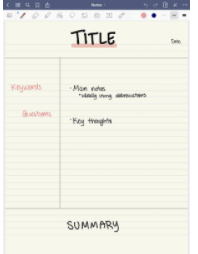Three Best Note Taking Methods
4 min read•november 23, 2021
Jessica Q.
Jessica Q.
Productivity ⏰
44 resourcesSee Units
Introduction to Note Taking
Welcome! Today we’ll be going over three of the best note taking methods; these can be used for almost any class and can be modified to fit your needs.
But first, why is note taking important? Does it actually help us absorb the information? The short answer is -- yes! If you’re forced to listen critically, you’ll be more likely to pay attention and avoid drifting off. In addition, with a bunch of information being thrown at you by your teacher or professor, taking notes forces you to write it concisely in your own words. This will help you actually understand what is being said instead of listening on autopilot.
Okay, now that we know note taking is one of the keys to academic success, finding a method that works for you is more important than ever! Let’s hop right into our first method: the outline method.
Method #1: Outline Method
The outline method is one of the simplest and most widespread forms of note taking. You start off with a bullet point covering a big idea, and then continue indenting your bullet points to cover more and more specific subpoints.
This method will help you create notes that are organized into different chunks of information, with each chunk containing specific details. After you’re finished with your notes, the outline method will easily allow you to convert them into practice questions to test yourself with.
Examples of Situations to Use this Method with
- An English lecture on the multiple themes covered in a reading, with each of the big ideas being a theme and the subpoints being explanations for why these themes relate to the reading
- An anatomy lesson, with each of the big ideas being body systems or parts and the subpoints being specific functions or details
- A social studies lecture on different societies or civilizations, with each of the big ideas being a civilization and the subpoints being different aspects of the society

(Image courtesy of GoodNotes)
Method #2: Cornell Notes
Our next method is Cornell Notes, which is another effective and commonly used note taking method. Not only does this method force you to pay attention DURING class, it also forces you to go back to your notes and review them AFTER class.
Here’s how to set up your note sheet for success. Divide your paper into imaginary fourths, with ¼ being a column on the left and ¾ being a larger column on the right. Also include a horizontal section at the bottom. Use the image as a reference for how to best set up your paper!
During class, use the larger column on the right to take notes, which can include bullet points, diagrams, charts, etc. After class is over, go back to the left column on your notesheet and write down important vocabulary words, questions you have, and main ideas. Lastly, use the section at the bottom to write a summary of the notes you took.
Cornell Notes are very effective for exam study as it picks out important words and ideas to remember.

(Image courtesy of GoodNotes)
💡 Check this out for more information on Cornell notes!
Method #3: Mind Mapping
Finally, our third method -- Mind mapping! If you’re a visual learner, this could be a particularly efficient method for you. Mind mapping is similar to our first method, the outline method, except in a more visual and condensed manner. One advantage it has over the outline method is that you’re able to see the relationships between ideas and subideas.
To set up each mind map, put your big idea in the middle. Include more specific ideas around your larger idea and draw branches connecting them to your idea in the middle. Continue expanding outward with more and more specific information.
Mind mapping forces you to condense all your information and lay it out in a format that makes it easy to see all at once.
Examples of Situations to Use this Method with
- A social studies lecture on the Civil War, with the Civil War being at the center and the branches connecting to ideas like important people, locations, etc.
- A marine biology lesson on an oceanic organism, with the organism being at the center and the branches connecting to ideas like its diet, habitat, etc.

(Image courtesy of MindMeister)
💡 Check out this video from Fiveable founder Amanda for more tips on note-taking!
Conclusion
Congratulations! Give yourself a pat on the back -- you made it to the end of this article! You should now have a better idea of three simple, yet effective, ways of note taking. These methods aren’t for everyone, and there are surely situations where one method would be better than another, but they can always be adjusted and modified to fit your needs.
Good luck on your note taking journey, and check out Fiveable for more resources!
Browse Study Guides By Unit

© 2023 Fiveable Inc. All rights reserved.